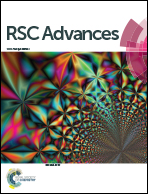Establishment and simulation of an electrode averaged model for a lithium-ion battery based on kinetic reactions†
Abstract
An accurate model for lithium-ion batteries is important for analyzing and predicting battery dynamic behavior. To better understand the relationship between battery internal dynamics and external measurement, a lithium-ion battery electrode averaged model, which is a simplified electrochemical model, is set up by considering lithium ion diffusion and migration based on the porous electrode theory and the concentrated solution theory. The electrode averaged model is established by solving the diffusion equation for lithium ions with the finite difference method and substituting the variables involved in the model with linear averages. To further simplify the model, the lithium ion concentration in the electrolyte phase is regarded as constant and the temperature is set as standard temperature (298 K). The derivation process of the lithium ion battery electrode averaged model is described in detail. In order to verify the rationality of the established operation and assumptions mentioned above as well as the accuracy of the electrode averaged model, the simulation results of the pseudo 2-dimensional model in the Dualfoil 5.2 program are regarded as reference values. Particularly, the lithium-ion battery electrode averaged model provides a simpler mathematical expression with fewer terms and higher computational efficiency. Besides, the electrode averaged model can provide precise variation of the terminal voltage during the charging and discharging processes.


 Please wait while we load your content...
Please wait while we load your content...